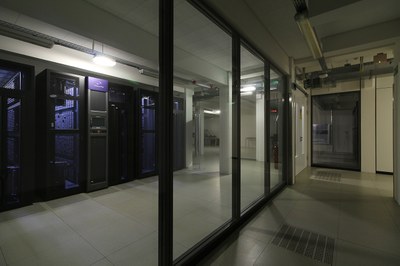01.03.2017
Conventional fire detection systems are not sufficient for use in the data archives, since even smoke alone would irreversibly destroy the data on the magnetic tapes. The same applies of course to an intervention of the fire brigade with water.
The oxygen reduction system, on the other hand, is based on the principle of fire prevention: The permanent reduction of the oxygen content in the ambient air will inhibit the development of fires in the first place. In order for a fire to occur, three conditions are required: a combustible substance, a sufficiently high ignition temperature and a sufficiently high proportion of oxygen in the ambient air. If one of these components is missing, no fire can start.
 At DKRZ, the data archive was sealed against the outside air by special partition walls. However, glass walls still allow visitors to take a look at the magnetic tape archives. Within the sealed area, the normal oxygen content of 21% is reduced to 17% by introducing nitrogen. At night, at weekends and outside of working hours (i.e. in more than half the time) the oxygen content will be even reduced to 15% in future, in order to further increase the safety concerning fire damage. Staying in rooms with this oxygen content is harmless to health, so that maintenance or control work can be carried out - even over longer periods of time. Most people have already experienced such low oxygen level during ski holiday or long-distance fights. An oxygen content of 17% corresponds to an altitude of 2,000 meters above sea level (source: wandernonline.de), 15% to an altitude of about 3,000 meters above sea level. Many mountain hikers, as well as skiers, move at this altitude, without the oxygen deficit.
At DKRZ, the data archive was sealed against the outside air by special partition walls. However, glass walls still allow visitors to take a look at the magnetic tape archives. Within the sealed area, the normal oxygen content of 21% is reduced to 17% by introducing nitrogen. At night, at weekends and outside of working hours (i.e. in more than half the time) the oxygen content will be even reduced to 15% in future, in order to further increase the safety concerning fire damage. Staying in rooms with this oxygen content is harmless to health, so that maintenance or control work can be carried out - even over longer periods of time. Most people have already experienced such low oxygen level during ski holiday or long-distance fights. An oxygen content of 17% corresponds to an altitude of 2,000 meters above sea level (source: wandernonline.de), 15% to an altitude of about 3,000 meters above sea level. Many mountain hikers, as well as skiers, move at this altitude, without the oxygen deficit.
In addition to the oxygen reduction system, the DKRZ has taken up further measures to protect the climate data: On the one hand, the magnetic tape archive is located in a room accessible to authorized persons only. On the other hand, another copy of the most important data (about 10% of the total data), such as the data for the IPCC assessment reports, is continually written via the German Research Network into a tape library that DKRZ operates at the "Max Planck Computing and Data Facility" in Garching near Munich.
